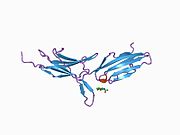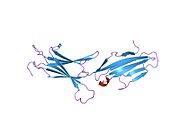Addressin
Mucosal vascular addressin cell adhesion molecule 1 (MAdCAM-1) is a protein that in humans is encoded by the MADCAM1 gene.[3][4][5] The protein encoded by this gene is an endothelial cell adhesion molecule that interacts preferentially with the leukocyte beta7 integrin LPAM-1 (alpha4 / beta7), L-selectin, and VLA-4 (alpha4 / beta1) on myeloid cells to direct leukocytes into mucosal and inflamed tissues. It is a member of the immunoglobulin superfamily and is similar to ICAM-1 and VCAM-1.[3]
Nomenclature
[edit]Addressin is a lesser-used term to describe the group of adhesion molecules that are involved with lymphocyte homing, commonly found at high-endothelial venules (HEVs) where lymphocytes exit the blood and enter the lymph node.[6][7] Addressins are the ligands to the homing receptors of lymphocytes.[8] The task of these ligands and their receptors is to determine which tissue the lymphocyte will enter next. They carry carbohydrates in order to be recognized by L-selectin.[9] Addressins physically bind to mobile lymphocytes to guide them to the HEVs.[6] Examples of molecules that are often referred to as addressins are CD34 and GlyCAM-1 on HEVs in peripheral lymph nodes, and MAdCAM-1 on endothelial cells in the intestine.[7]
Function
[edit]In terms of migration, MAdCAM-1 is selectively expressed on mucosal endothelial cells, driving memory T-cell re-circulation through mucosal tissues. In contrast, and indeed the main difference between the two molecules, ICAM molecules are involved with naïve T-cell re-circulation. Whereas MAdCAM-1 is selectively expressed, ICAM is broadly expressed on inflamed endothelium.
Peripheral node addressins
[edit]Peripheral node addressins (PNAd) are carbohydrate residues that are lymphocyte homing receptor ligands that are expressed on the HEVs of peripheral lymph nodes.[10] These proteins collectively bind to L-selectin to guide lymphocytes such as mature naïve B and T cells into the lymph node.[9][11][12] During the development of secondary lymphoid organs, PNAd expression is upregulated following the upregulation and subsequent downregulation of MAdCAM-1 on HEVs.[12] PNAd expression, as well as the expression of MAdCAM-1, is dependent on lymphotoxin signaling in the HEVs of lymph nodes.[12]
Clinical significance
[edit]In inflammatory bowel diseases, MAdCAM-1 can be overexpressed on the endothelial cells of intestinal mucosa and gut-associated lymphoid tissue, leading to excessive inflammation in the gut.[13] A potential therapeutic target to manage these diseases could be the MAdCAM-1 molecules that are expressed on these cells and bring in lymphocytes. One example of a potential therapy is the fully human monoclonal antibody ontamalimab that targets and binds to MAdCAM-1, preventing it from interacting with the integrins on the surface of the lymphocytes.[14]
See also
[edit]References
[edit]- ^ a b c GRCh38: Ensembl release 89: ENSG00000099866 – Ensembl, May 2017
- ^ "Human PubMed Reference:". National Center for Biotechnology Information, U.S. National Library of Medicine.
- ^ a b "Entrez Gene: mucosal vascular addressin cell adhesion molecule 1".
- ^ Shyjan AM, Bertagnolli M, Kenney CJ, Briskin MJ (April 1996). "Human mucosal addressin cell adhesion molecule-1 (MAdCAM-1) demonstrates structural and functional similarities to the alpha 4 beta 7-integrin binding domains of murine MAdCAM-1, but extreme divergence of mucin-like sequences". Journal of Immunology. 156 (8): 2851–7. doi:10.4049/jimmunol.156.8.2851. PMID 8609404. S2CID 24940438.
- ^ Leung E, Berg RW, Langley R, Greene J, Raymond LA, Augustus M, et al. (1997). "Genomic organization, chromosomal mapping, and analysis of the 5' promoter region of the human MAdCAM-1 gene". Immunogenetics. 46 (2): 111–9. doi:10.1007/s002510050249. PMID 9162097. S2CID 9453114.
- ^ a b Bevilacqua MP (1993-04-01). "Endothelial-leukocyte adhesion molecules". Annual Review of Immunology. 11 (1): 767–804. doi:10.1146/annurev.iy.11.040193.004003. PMID 8476577.
- ^ a b Punt J (2019). Kuby immunology. Sharon A. Stranford, Patricia P. Jones, Judith A. Owen (Eighth ed.). New York. ISBN 978-1-4641-8978-4. OCLC 1002672752.
{{cite book}}: CS1 maint: location missing publisher (link) - ^ Addressin Archived 2016-12-01 at the Wayback Machine at eMedicine Dictionary
- ^ a b Berg EL, Robinson MK, Warnock RA, Butcher EC (July 1991). "The human peripheral lymph node vascular addressin is a ligand for LECAM-1, the peripheral lymph node homing receptor". The Journal of Cell Biology. 114 (2): 343–9. doi:10.1083/jcb.114.2.343. PMC 2289069. PMID 1712790.
- ^ Picker LJ, Butcher EC (1992-04-01). "Physiological and molecular mechanisms of lymphocyte homing". Annual Review of Immunology. 10 (1): 561–91. doi:10.1146/annurev.iy.10.040192.003021. PMID 1590996.
- ^ Lechleitner S, Kunstfeld R, Messeritsch-Fanta C, Wolff K, Petzelbauer P (September 1999). "Peripheral lymph node addressins are expressed on skin endothelial cells". The Journal of Investigative Dermatology. 113 (3): 410–4. doi:10.1046/j.1523-1747.1999.00696.x. PMID 10469342.
- ^ a b c Randall TD, Carragher DM, Rangel-Moreno J (2008-03-27). "Development of secondary lymphoid organs". Annual Review of Immunology. 26 (1): 627–50. doi:10.1146/annurev.immunol.26.021607.090257. PMC 2590644. PMID 18370924.
- ^ Arihiro S, Ohtani H, Suzuki M, Murata M, Ejima C, Oki M, et al. (2002). "Differential expression of mucosal addressin cell adhesion molecule-1 (MAdCAM-1) in ulcerative colitis and Crohn's disease". Pathology International. 52 (5–6): 367–74. doi:10.1046/j.1440-1827.2002.01365.x. PMID 12100519. S2CID 38219521.
- ^ Picardo S, Panaccione R (April 2020). "Anti-MADCAM therapy for ulcerative colitis". Expert Opinion on Biological Therapy. 20 (4): 437–442. doi:10.1080/14712598.2020.1691520. PMID 31709847. S2CID 207946274.
Further reading
[edit]- Ohara H, Isomoto H, Wen CY, Ejima C, Murata M, Miyazaki M, et al. (December 2003). "Expression of mucosal addressin cell adhesion molecule 1 on vascular endothelium of gastric mucosa in patients with nodular gastritis". World Journal of Gastroenterology. 9 (12): 2701–5. doi:10.3748/wjg.v9.i12.2701. PMC 4612036. PMID 14669317.
- Ikeda S, Kudsk KA, Fukatsu K, Johnson CD, Le T, Reese S, Zarzaur BL (May 2003). "Enteral feeding preserves mucosal immunity despite in vivo MAdCAM-1 blockade of lymphocyte homing". Annals of Surgery. 237 (5): 677–85, discussion 685. doi:10.1097/01.SLA.0000064364.40406.EA. PMC 1514523. PMID 12724634.
- Tan K, Casasnovas JM, Liu JH, Briskin MJ, Springer TA, Wang JH (June 1998). "The structure of immunoglobulin superfamily domains 1 and 2 of MAdCAM-1 reveals novel features important for integrin recognition". Structure. 6 (6): 793–801. doi:10.1016/S0969-2126(98)00080-X. PMID 9655832.
- de Château M, Chen S, Salas A, Springer TA (November 2001). "Kinetic and mechanical basis of rolling through an integrin and novel Ca2+-dependent rolling and Mg2+-dependent firm adhesion modalities for the alpha 4 beta 7-MAdCAM-1 interaction". Biochemistry. 40 (46): 13972–9. doi:10.1021/bi011582f. PMID 11705388.
- Miles A, Liaskou E, Eksteen B, Lalor PF, Adams DH (May 2008). "CCL25 and CCL28 promote alpha4 beta7-integrin-dependent adhesion of lymphocytes to MAdCAM-1 under shear flow". American Journal of Physiology. Gastrointestinal and Liver Physiology. 294 (5): G1257-67. doi:10.1152/ajpgi.00266.2007. PMID 18308860.
- Kimura K, Wakamatsu A, Suzuki Y, Ota T, Nishikawa T, Yamashita R, et al. (January 2006). "Diversification of transcriptional modulation: large-scale identification and characterization of putative alternative promoters of human genes". Genome Research. 16 (1): 55–65. doi:10.1101/gr.4039406. PMC 1356129. PMID 16344560.
- Grayson MH, Hotchkiss RS, Karl IE, Holtzman MJ, Chaplin DD (June 2003). "Intravital microscopy comparing T lymphocyte trafficking to the spleen and the mesenteric lymph node". American Journal of Physiology. Heart and Circulatory Physiology. 284 (6): H2213-26. doi:10.1152/ajpheart.00999.2002. PMID 12586641.
- Fujisaki S, Tomita R, Park YJ, Kimizuka K, Sugitoh K, Inoue M, Fukuzawa M (March 2004). "Semiquantative analysis of expression of mucosal addressin cell adhesion molecule-1 during small bowel graft rejection in rats". Transplantation Proceedings. 36 (2): 348–9. doi:10.1016/j.transproceed.2003.12.010. PMID 15050155.
- Nishimura T (2003). "Expression of potential lymphocyte trafficking mediator molecules in the mammary gland". Veterinary Research. 34 (1): 3–10. doi:10.1051/vetres:2002045. PMID 12588680.
- Ogawa H, Binion DG, Heidemann J, Theriot M, Fisher PJ, Johnson NA, et al. (February 2005). "Mechanisms of MAdCAM-1 gene expression in human intestinal microvascular endothelial cells". American Journal of Physiology. Cell Physiology. 288 (2): C272-81. doi:10.1152/ajpcell.00406.2003. PMID 15483224.
- Ruiz-Velasco N, Guerrero-Esteo M, Briskin MJ, Teixidó J (March 2000). "The alpha(4) integrin subunit Tyr(187) has a key role in alpha(4)beta(7)-dependent cell adhesion". The Journal of Biological Chemistry. 275 (10): 7052–9. doi:10.1074/jbc.275.10.7052. hdl:10261/169140. PMID 10702270.
- Di Sabatino A, Rovedatti L, Rosado MM, Carsetti R, Corazza GR, MacDonald TT (May 2009). "Increased expression of mucosal addressin cell adhesion molecule 1 in the duodenum of patients with active celiac disease is associated with depletion of integrin alpha4beta7-positive T cells in blood". Human Pathology. 40 (5): 699–704. doi:10.1016/j.humpath.2008.10.014. PMID 19157500.
- Bowlus CL, Karlsen TH, Broomé U, Thorsby E, Vatn M, Schrumpf E, et al. (November 2006). "Analysis of MAdCAM-1 and ICAM-1 polymorphisms in 365 Scandinavian patients with primary sclerosing cholangitis". Journal of Hepatology. 45 (5): 704–10. doi:10.1016/j.jhep.2006.03.012. PMID 16750586.
- Ambruzova Z, Mrazek F, Raida L, Stahelova A, Faber E, Indrak K, Petrek M (June 2009). "Possible impact of MADCAM1 gene single nucleotide polymorphisms to the outcome of allogeneic hematopoietic stem cell transplantation". Human Immunology. 70 (6): 457–60. doi:10.1016/j.humimm.2009.03.008. PMID 19286444.
- Arihiro S, Ohtani H, Suzuki M, Murata M, Ejima C, Oki M, et al. (2002). "Differential expression of mucosal addressin cell adhesion molecule-1 (MAdCAM-1) in ulcerative colitis and Crohn's disease". Pathology International. 52 (5–6): 367–74. doi:10.1046/j.1440-1827.2002.01365.x. PMID 12100519. S2CID 38219521.
- Shroff HN, Schwender CF, Baxter AD, Brookfield F, Payne LJ, Cochran NA, et al. (July 1998). "Novel modified tripeptide inhibitors of alpha 4 beta 7 mediated lymphoid cell adhesion to MAdCAM-1". Bioorganic & Medicinal Chemistry Letters. 8 (13): 1601–6. doi:10.1016/S0960-894X(98)00286-8. PMID 9873398.
- Dando J, Wilkinson KW, Ortlepp S, King DJ, Brady RL (February 2002). "A reassessment of the MAdCAM-1 structure and its role in integrin recognition" (PDF). Acta Crystallographica. Section D, Biological Crystallography. 58 (Pt 2): 233–41. Bibcode:2002AcCrD..58..233D. doi:10.1107/S0907444901020522. PMID 11807247.
External links
[edit]- vascular+addressins at the U.S. National Library of Medicine Medical Subject Headings (MeSH)
- Human MADCAM1 genome location and MADCAM1 gene details page in the UCSC Genome Browser.
- Overview of all the structural information available in the PDB for UniProt: Q13477 (Mucosal addressin cell adhesion molecule 1) at the PDBe-KB.
This article incorporates text from the United States National Library of Medicine, which is in the public domain.


 French
French Deutsch
Deutsch



